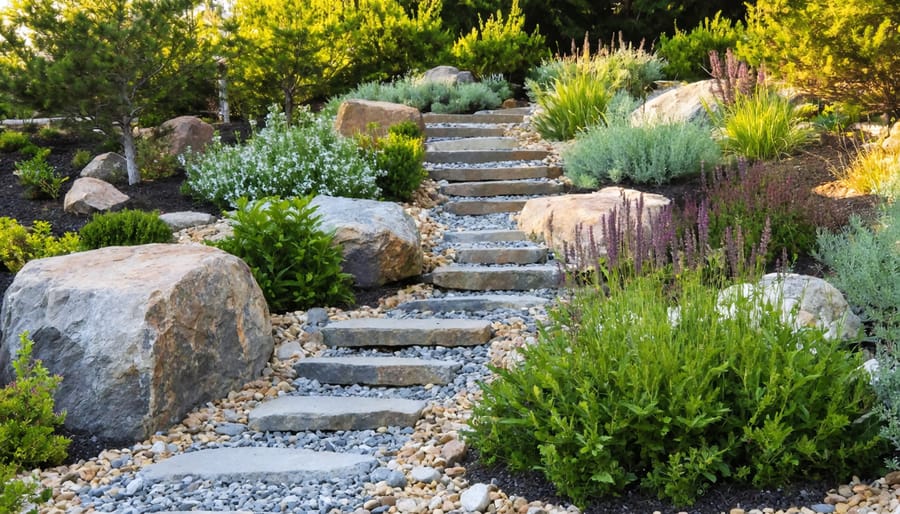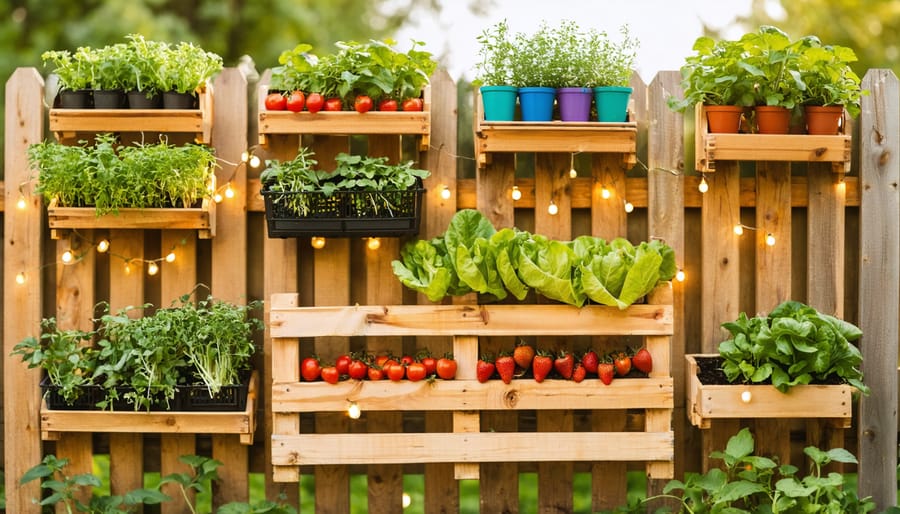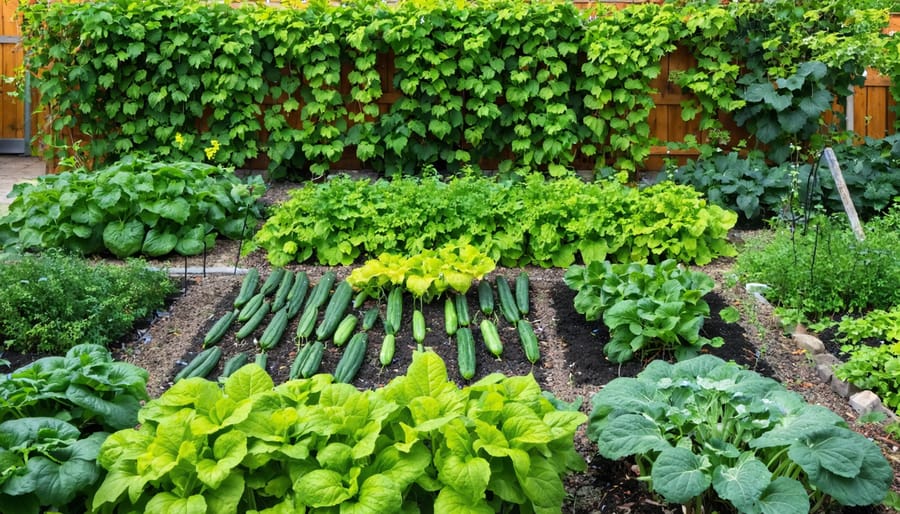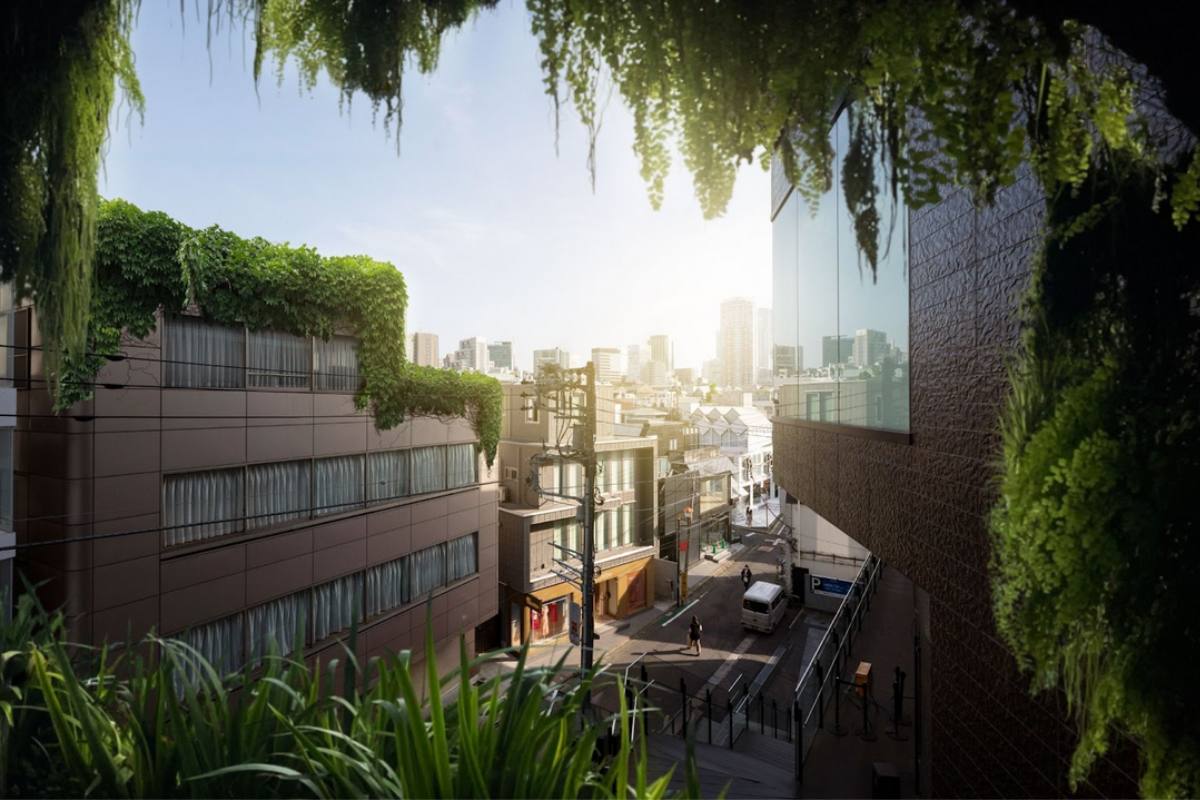Transform a barren yard into a striking self-maintaining garden design by strategically placing large, weather-resistant boulders as focal points, then layering smaller rocks to create natural-looking elevation changes. Select drought-tolerant perennials like sedum, creeping thyme, and ornamental grasses that thrive in rocky conditions and require minimal watering. Position slow-growing evergreen shrubs between rock clusters to anchor the design while preventing weed growth. Line pathways with crushed gravel or decomposed granite to eliminate mowing needs and naturally suppress unwanted vegetation. This timeless approach to landscaping delivers year-round visual interest while demanding just occasional seasonal maintenance – perfect for busy homeowners seeking beauty without the burden of constant upkeep.
Planning Your Low-Maintenance Rock Garden
Choosing the Perfect Location
Selecting the right location for your rock garden is crucial for its long-term success and ease of maintenance. Start by observing your yard throughout the day to identify areas that receive at least 6 hours of sunlight, as most rock garden plants thrive in full sun. South or west-facing spots are typically ideal.
Excellent drainage is non-negotiable for a rock garden. Choose a natural slope if you have one, or consider creating a gentle incline. You can test drainage by digging a 12-inch hole, filling it with water, and checking how quickly it drains. If water remains after 24 hours, you’ll need to improve drainage or select a different spot.
Consider visibility when choosing your location. A rock garden can serve as a striking focal point near your home’s entrance or be positioned where you can enjoy it from your favorite window. Avoid areas under trees where falling leaves will create extra maintenance work, and steer clear of spots where water collects during rain.
For urban gardens, even a small sunny corner can become the perfect rock garden setting. Just ensure it’s easily accessible for the minimal maintenance you’ll need to perform.
Simple Layout Patterns That Work
Creating a visually appealing rock garden doesn’t require complex designs. The most effective layouts often follow simple, natural patterns that are both beautiful and easy to maintain. Start with the classic crescent design, where rocks gradually curve around a focal point, creating a gentle flow that mimics natural landscapes. This pattern works particularly well against house walls or in corner spaces.
Another foolproof layout is the stepped approach, where larger rocks are positioned at different heights to create natural-looking levels. This design is perfect for sloped areas and provides excellent drainage while adding visual interest. For flat spaces, try the cluster pattern – groups of three to five rocks arranged naturally, as if they’ve always been there, with plenty of space between clusters for low-growing plants.
The island design is another low-maintenance favorite, featuring a central rock grouping surrounded by smaller stones and drought-resistant plants. This layout works well in both small and large spaces and requires minimal upkeep once established. For those with limited space, the linear pattern along pathways or borders offers a clean, organized look while maintaining simplicity in care and design.

Rock Selection and Placement
Types of Rocks to Use
When selecting rocks for your low-maintenance garden, focus on locally sourced stones that naturally complement your landscape. Limestone and sandstone are excellent choices for most gardens, as they weather beautifully and provide a natural look. For a more dramatic effect, granite offers durability and comes in various shades from gray to pink.
In warm climates, light-colored rocks like quartz or white limestone help reflect heat and create striking contrasts with plants. Desert regions benefit from red sandstone or slate, which echo the natural surroundings while standing up to intense sun exposure.
For rainfall-heavy areas, opt for smooth river rocks or dense granite, as they resist erosion and maintain their appearance over time. Avoid soft rocks like shale that can break down quickly. Mixing different sizes is key – incorporate larger anchor rocks (2-3 feet across) with medium-sized stones (6-12 inches) and smaller gravel to create visual interest and improve drainage.
Remember that local stones not only look more natural but are often less expensive and more sustainable, as they require less transportation and adapt well to your climate conditions.

Natural-Looking Arrangement Tips
Creating a natural-looking rock garden is all about mimicking Mother Nature’s artistry. Start by observing how rocks appear in natural settings – they’re rarely lined up perfectly or evenly spaced. Instead, try clustering rocks in irregular groups of three or five, which creates more organic-looking formations. When placing larger rocks, partially bury them so they appear to have been there for years, with about one-third of the rock beneath the soil.
For more inspiration, check out these stunning rock design ideas that showcase natural arrangements. Consider positioning rocks with their best face forward and slightly tilted backward to catch rainwater. This not only looks more authentic but also helps direct water toward your plants.
Layer different-sized rocks, placing larger ones at the base and gradually working up to smaller ones. Think of how rocks would naturally tumble down a hillside. Incorporate some weathered rocks alongside newer ones to add character and age to your garden. Remember to leave enough space between rock groupings for plants to grow and spread naturally, creating that perfect balance between hardscape and greenery.

Low-Maintenance Plants for Rock Gardens
Drought-Resistant Succulents
Succulents are the perfect choice for rock gardens, offering stunning visual appeal with minimal care requirements. Sedum varieties, particularly ‘Dragon’s Blood’ and ‘Autumn Joy,’ thrive in rocky environments and provide year-round interest with their changing colors. The striking Sempervivum (Hens and Chicks) naturally complements rock features and spreads gradually to fill empty spaces.
For vertical interest, consider Echeveria elegans, whose pale blue-green rosettes create an enchanting contrast against rocks. Agave americana, while larger, makes a dramatic focal point and can withstand long periods without water. The low-growing ice plant (Delosperma) offers brilliant bursts of color during blooming seasons while maintaining its drought-resistant nature.
These hardy succulents not only survive but flourish in challenging conditions. Most require just occasional watering once established, making them ideal for busy gardeners. For best results, plant them in well-draining soil and position them where they’ll receive at least 6 hours of sunlight daily. Their thick, fleshy leaves store water efficiently, allowing them to thrive even during extended dry spells.
Remember to space your succulents appropriately, as most will spread over time, creating a natural, abundant look in your rock garden.
Hardy Perennials That Last
When it comes to creating a lasting rock garden, choosing the right low-maintenance perennials is essential. Sedum varieties, particularly ‘Autumn Joy’ and ‘Dragon’s Blood,’ are rockstars in these spaces, forming dense, colorful mats that suppress weeds and return reliably year after year. Creeping Phlox cascades beautifully over rocks, creating stunning spring displays in pink, purple, or white, while requiring minimal care beyond occasional trimming.
Sempervivum (Hens and Chicks) truly lives up to its “forever living” name, thriving in rocky conditions and multiplying on its own. Ice Plant (Delosperma) offers drought-resistant ground coverage with daisy-like blooms that light up summer gardens. For vertical interest, consider Yarrow, which stands tall with flat-topped flower clusters and ferny foliage that stays attractive all season.
These hardy plants not only survive but thrive in rocky, well-drained soil, making them perfect companions for your rock garden design. Once established, they need minimal watering and actually prefer being left alone, proving that beautiful gardens don’t have to be high-maintenance.
Ground Covers That Control Weeds
Ground covers are your secret weapon for a low-maintenance rock garden. Creeping thyme, sedum, and creeping phlox not only create stunning carpets of color but naturally prevent weeds from taking hold. These hardy plants spread quickly to form dense mats that shade the soil, making it difficult for unwanted seeds to germinate. Stonecrop varieties are particularly effective, thriving in poor soil and harsh conditions while crowding out invasive species. For shaded areas, consider Japanese pachysandra or sweet woodruff, which provide excellent coverage and require minimal care once established. The best part? Most of these ground covers are drought-tolerant and only need occasional trimming to stay tidy, making them perfect partners for your rock garden design.
Simple Maintenance Tips
Keeping your rock garden looking its best doesn’t have to be time-consuming. With these simple maintenance tips, you can enjoy a beautiful garden while spending more time relaxing than working in it.
Start by removing weeds as soon as you spot them, before they have a chance to establish deep roots. A quick weekly walk-through, pulling any emerging weeds, prevents them from becoming a bigger problem later. Laying down landscape fabric beneath your rocks during installation significantly reduces weed growth.
Water deeply but infrequently to encourage drought-resistant plants to develop strong root systems. Most rock garden plants prefer well-drained soil and can tolerate dry conditions once established. During extended dry spells, water early in the morning to minimize evaporation.
Trim back any dead or yellowing foliage from your plants seasonally, typically in early spring and late fall. This not only keeps your garden looking tidy but also promotes healthy growth. Many rock garden plants are naturally compact, requiring minimal pruning.
Check your rocks periodically, especially after heavy rains or frost, to ensure they haven’t shifted position. Gently reposition any displaced stones to maintain your design and prevent soil erosion. A quick rinse with a garden hose once or twice a year keeps rocks looking fresh and vibrant.
Apply a thin layer of gravel mulch every couple of years to refresh the garden’s appearance and help suppress weeds. Remove fallen leaves and debris regularly to prevent them from decomposing between rocks and creating unwanted soil buildup.
Remember, the key to low-maintenance success is choosing the right plants and materials from the start, then establishing a simple routine of quick, regular check-ups rather than intensive periodic maintenance.
Creating a low-maintenance rock garden doesn’t have to be overwhelming or complex. By following the design principles we’ve discussed, choosing the right rocks and plants, and implementing proper drainage, you can create a stunning landscape feature that practically takes care of itself. Remember to start small, plan your layout carefully, and select drought-resistant plants that complement your local climate. Whether you’re working with a sunny corner or a challenging slope, a rock garden offers endless possibilities for creative expression while minimizing the time spent on upkeep. So grab your gardening gloves and start collecting those perfect rocks – your dream low-maintenance rock garden awaits! With just a weekend’s worth of effort, you can create a beautiful outdoor space that will bring you joy for years to come.




